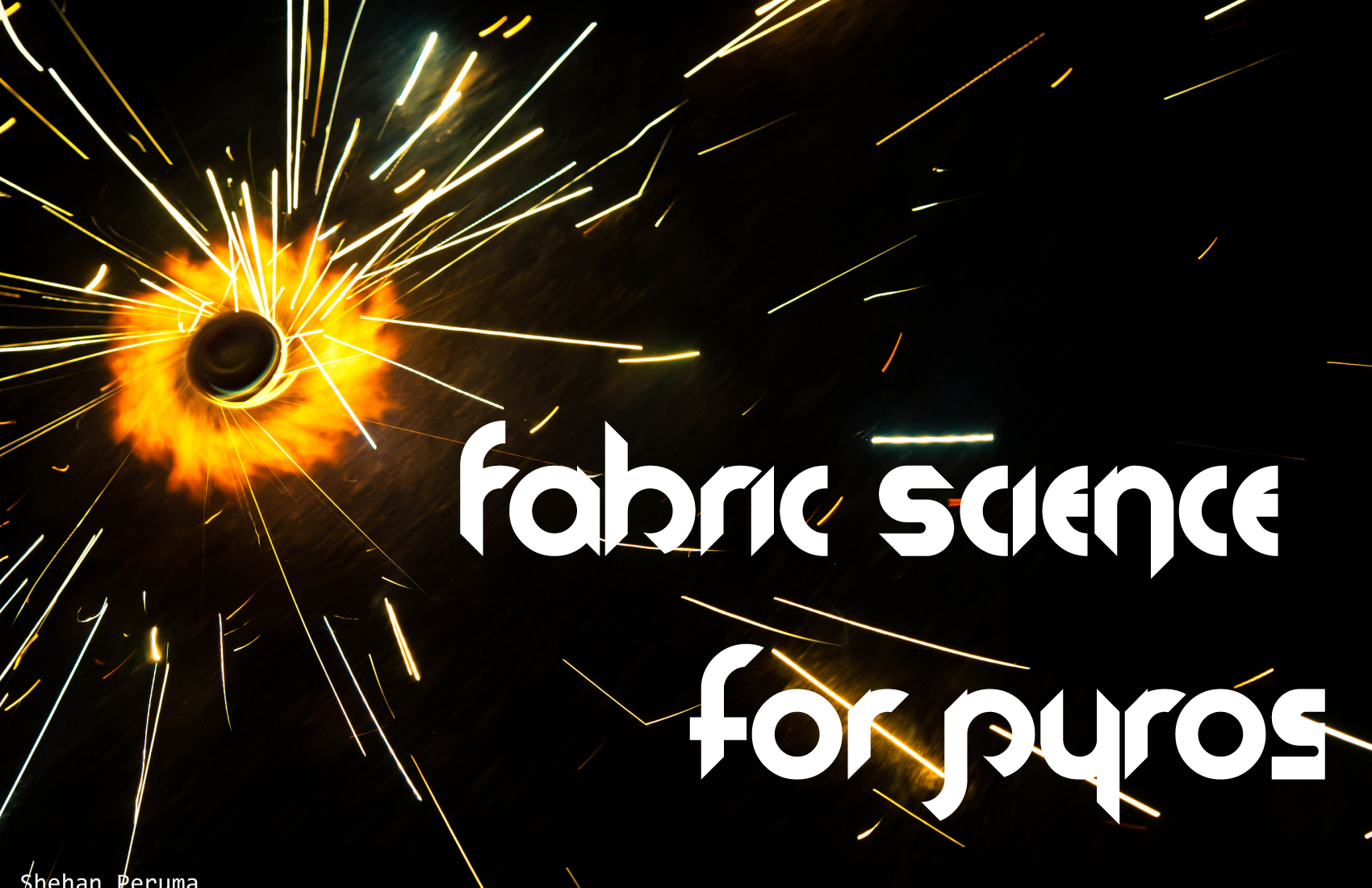Tara has created this glossary of terms and fabrics that she has tested in order to help educate the community.
Costuming is just as important (if not more) than your spinning environment. If an event planner or troupe leader is supplying the costumes, insist on seeing them in advance for a dress rehearsal. You don’t want to get to a gig and find out you are wearing a big awkward flowy costume made completely out of petroleum products. If you think the costume is unsafe, work with the client to make/buy a comparable costume that is fire safe. Don’t be afraid to step on a client’s toes to prevent accidents that could injure their audience; in the end they will thank you for your knowledge and professionalism.
Here are a few guidelines on what to look for in a costume:
#1- Fiber content:
Synthetic materials such as polyester, Acrylic, nylon, Olefin and spandex (aka lycra) are made from petroleum products; they are essentially made of fuel! These fabrics burn as you would expect plastic to burn – smoldering, molten, volatile and hard to extinguish. Synthetic yarns are created by melting down a vat of plastic and extruding it into a cooling chamber to create yarn. These fabrics are engineered to melt very easily, that’s what makes it cheap to produce and dangerous around high heat and flames. When these fabrics are exposed to high temperatures, they will shrivel and melt, cling to your skin and burn you. If they catch on fire, the fire will rapidly grow, traveling up the fabric and rain flaming molten plastic. A synthetic garment on fire will cause burns with blisters and scar tissue that has remnants of the synthetic material embedded inside the skin.
Natural fibers such as leather, wool, cotton, linen, flax, and silk are made from naturally occurring organic materials. They burn as you would expect wood to burn, they catch on fire and turn to ash. A garment made of natural fibers can catch on fire but it will not melt into your skin.
How to test: By law, all garments sold in the USA must be labeled with where they are made and what they are made of. The tag should be on the center back of the garment or on the right side in the middle of a garment. Most garments made overseas are made from synthetic fabrics because of tariffs on foreign cotton. If there are no labels, a burn test on the edge of the fabric can be conducted. To do this, ignite the edge of the fabric, allow it to burn for a second and extinguish it, then pinch the charred edge. If the fabric produces ash, its natural, if it melts and solidifies as a bead of plastic, it’s synthetic.
#2- weight of fabric: this is commonly overlooked by fire spinners when discussing fire safe fabrics. The weight of any fabric directly correlates to how quickly it will ignite and spread. Just like starting a campfire (you use thin wood as kindling), the same goes for fabric – the lighter the fabric, the quicker it will ignite and spread. A nice thick material will give you plenty of reaction time from the moment you make contact with a flame. 6 seconds is a good rule of thumb. If you want to test how long it takes for fabric to ignite, I recommend testing the center of the fabric rather than the edge.
#3- fit and finish: Remember science and cooking class? No low hanging sleeves or drapey clothes! Big bell sleeves look great on a wizards robe but how are you going to spin poi in that? Tight costumes (that are not made of spandex) are safer than loose ones. Frayed edges, cheesecloth, tulle and fringe can catch on fire very quickly this means things like tutus, fringe flapper dresses, gauzy ghost robes and torn up zombie costumes are potentially dangerous to spin in. All of this should be considered with what and how you are spinning, think about your prop, your moves and how your costume may get in the way and tangle you up. Dress rehearsals can be very eye opening!
Costume styling, do it yourself!
Before I started my clothing line for fire spinners, my day job was designing Halloween costumes for a major company that sells at Walmart, Target, Halloween Adventure, Dollar General, Duane Reade and so on. Sure, it was a fun job but after seeing how those costumes are made, I will never spend my money on one and I certainly would NEVER spin fire in one.
The name of the game for Halloween is CHEAP. If you are getting an entire outfit in a bag for $25, it cost less than $5 to make in China (including labor, materials and shipping!!). How do they make it so cheap? Cheap Chinese labor, cheap synthetic materials and customs loopholes. They are so poorly made they are not even considered clothing. Most Halloween costumes don’t come with the props and accessories photographed on the packaging, they also use higher quality costumes for the photograph than what’s actually inside.
The key to all Halloween costumes are the accessories, Take any dress and add a pointy hat and it’s a witch costume, add wings and you’re a fairy, add a tiara and you’re a princess add ears/tail and you’re an animal. For men a robe or pants and a top can be transformed into a wizard, ninja, pirate, vampire, zombie, etc. with some accessories, props and/or make up. You can pick up accessories at a Halloween shop or make them yourself out of non-flammable materials and make sure they are not going to get in the way of spinning.
Chances are, you already have a cotton outfit you feel comfortable spinning in. If you don’t, you can get something basic made of natural fibers at a thrift store. Consider using leather fringe ( http://www.tandyleatherfactory.com/en-usd/search/searchresults/5035-54.aspx ) as an alternative to feathers, fabric fringe and mangled edges. Be careful with dangling pieces like chains or tails and clumsy things on your head like tall hats or ears. I recommend attaching clips into hoods or hats or add a loophole for bobby pins; you don’t want it falling in your face during a performance.
If you have no other choice than to spin fire in dangerous materials, Flamex spray (http://www.natfire.com/product_p/fxpf-32.htm ) is a great way to protect the fabric from igniting. It creates a waxy film over the fabric that prevents it from igniting, like wetting down your costume or hair. It’s not perfect – it washes off and the fabric can still heat up and shrivel attaching itself to your skin and cause burns, but the fabric won’t ignite and cause the fire to spread. For stylish costumes designed for fire spinning, that will not ignite, never melt and built to last, feel free to check out my Etsy shop for 3rd Earth Fireproof ( https://www.etsy.com/shop/3rdEarthFireproof?ref=si_shop ) .
Have a safe and fun Halloween, dress up, live your fantasies and burn brightly!
About Tara Mc Manus:
Tara has been designing for fashion, building costumes, accessories, masks, props and puppets in NYC for the past 13 years. She performs and teaches all things fire professionally, including hands on fire safety classes. Her clothing line, 3rd Earth Fireproof ( https://www.etsy.com/shop/3rdEarthFireproof?ref=si_shop ), is dedicated to fire performers and the only one of its kind. With a focus on innovative flame retardant materials and finishes, Tara has achieved major breakthroughs in FR costuming. This past summer, she vended at 17 fire festivals and taught “Fabric Science for Pyros” at many of them. She is also in the process of making a comprehensive report on burn times of fabrics of varying fiber content and weights. On top of all this, she is cofounder and event producer of the Floasis, board member of NAFAA and moderator of the Fire Safety Discussion group on Facebook.
Reblogged from F.I.R.E. Arts Magazine. See the original article here.[/fusion_builder_column][/fusion_builder_row][/fusion_builder_container]





Comments 3
poppe tsnuami
1:35 you note how modal with 5% spandex blend does have some meltiness but not melting to skin so ok to wear. most non-performers aka ‘average joes’ dont wear modal vs cotton/denim so applying this to a wider audience…. what blend in your estimation becomes borderline dangerous? 8%? 10%? many blends now for winter socks/pants are tops 65-80% natural, so kinda need to know.
vonshango
or Tara Mc Manus (whoever is in the video)
hi tara,
turns out the email form on flowartsinstitute site doesn’t confirm it has ‘sent’ message with chrome/win10 so i was forced to try different emails.
i like your work on synthetic fibers dripping fusing into skin with exposure to heat (more than flame). left ideas on how to reshoot it. if ever in bay area let me know via email.
what % natural/synthetic blend you would not wear aka would you wear 66% natural and 33% synthetic or nothing under 80% natural?
you are the one to ask.
wolf